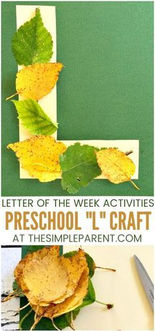Thanksgiving and the Letter Ll
Happy Thanksgiving
Thanksgiving is this week, but the holiday will look and feel very different to most of us this year. It may be difficult to feel thankful right now. While many of the activities and videos below center around a traditional (non-Covid) Thanksgiving, the book, "God Gave Us Thankful Hearts" (see video below) helps us to remember that even when we are feeling sad, there are still things to be thankful for. Maybe your family would like to create a craft together, like the Thankful tree below, to help focus a discussion around what you are each thankful for this year. I am thankful for each of you and for our preschool (despite the fact we aren't meeting in person quite yet) and pray that this week you are able to celebrate the blessings in your life, and have a peaceful, happy Thanksgiving.
Number Sense: Counting
Counting is a foundational skill necessary for the development of mathematical concepts. It's more than just reciting numbers; it's saying these numbers in order to take an account of a group of items to determine the total. Studies suggest that children who are able to count to at least 20 prior to entering kindergarten, do better in kindergarten and first grade math. According to Sarah Punkoney, on her Stay at Home Mama blog, there are five stages of learning to count:
-
Stable Order: Stable order is rote counting in the correct order using number names. It is basic 1, 2, 3, 4, and so on. When a child is deloping stable order counting skills he may skip numbers, 1, 2, 3, 5, 6… or may use the same number more than once, 1, 2, 3, 2…
-
One-to-One Correspondence: One-to-one correspondence is the understanding that each item is counted only once and one at a time. For example, when counting a set of counting bears, the child does not count any one bear twice and does not count any bear with another, assigning the same number.
-
Cardinally: Cardinally is the understanding that counting is quantitative and the last number named is the total of the group. For example, when a child is counting a group of five butterflies, she counts 1, 2…5 with the understanding that the number of butterflies counted is five, not any of the previous numbers counted.
-
Order Irrelevant: The order of counting does not affect the total. For example, when counting a line of buttons, the buttons can be counted forward, backward, or in any order and the total amount will remain the same.
-
Abstraction: Eventually, children come to understand that both objects and ideas can be counted. One example of this is actually in phonological awareness lessons where children are asked to listen for and count words in sentences.
There are a number of fun, hands-on activities and toys you can use to help teach these concepts (some of which are available to print from the Internet), but simply modeling and speaking out loud while you are counting is helpful as well. Reciting nursery rhymes and singing songs, like "One Two Buckle My Shoe, " "There Were Ten In the Bed," or "Ants Go Marching," are some good ones. As for books that include counting, "The Very Hungry Caterpillar," "Ten Turkeys in the Road," Over in the Meadow,"(be sure to check out one of the song versions of this story) and "The 1-2-3's of D&D," are all fun options. Jamie, in her Hands On As We Grow blog, lists several additional ideas for practicing counting with your child, including:
-
Roll the dice. Count them. Stack the blocks. Count them. Repeat.
-
Make a simple grid on the sidewalk with numbers and find that many objects from nature!
-
Make a paper chain and count down to something exciting (a birthday, holiday, first day of school, last day of school, vacation, etc)! Every day, count how many chains are left to see how many more days.
In our classes, we like to have kids get up and move as they're counting. For example, when we are learning about the calendar each day, we jump or clap with each number as we count towards the current date. If you have older kids, it might be fun to task him/her with creating a counting game, too. As always, regardless of what you're learning with your preschooler, it's important to keep it fun and upbeat!
Zoo Phonic Friend: Lizzy Lizard, Ll
Lizzy Lizard is our animal friend this week. The movement for Lizzy is to put your hands about an inch under your chin so that as you say the L sound, your chin drops down to touch your fingers, as in the video below. As you are learning about the letter L and lizards, if you're comfortable, it would be fun to visit the local pet store to check out their reptile section. The gallery below also has some cute craft ideas to reinforce this phonic.















